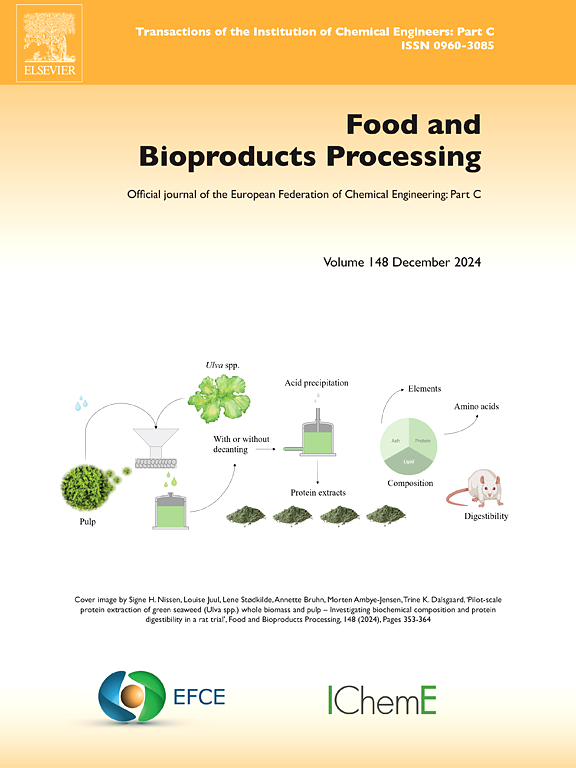Advanced blanching technology for Exocarpium citri grandis: Optimizing processes and unraveling the enhancement mechanism of drying efficiency
IF 3.4
2区 农林科学
Q2 BIOTECHNOLOGY & APPLIED MICROBIOLOGY
引用次数: 0
Abstract
In the quest for higher drying efficiency and quality of large-size Exocarpium citri grandis (ECG, a large citrus fruit), cutting-edge blanching technology has been unlocked as a pre-treatment. The effects of high-humidity hot air impingement blanching (HHAIB), vacuum-steam pulse blanching (VSPB), and hot water blanching (HWB) on the drying characteristics, and physicochemical quality of ECG at various core temperatures (30–70 ℃) were evaluated, and the drying promote mechanism was elucidated. Results showed that the average heating rates of HHAIB (4.73 %) and VSPB (4.84 %) were lower than those of HWB (6.99 %), but they were not significantly different. HHAIB effectively improved the ECG’s drying rate, flavonoid content, and color while reducing peroxidase activity, shrinkage, and hardness. In contrast, HWB and VSPB resulted in unfavorable nutrient loss and crumpling. Cell-wall polysaccharides and crystallinity properties analysis revealed that HHAIB induced deterioration of chelate-soluble pectin (CSP), Na2CO3-soluble pectin (NSP), and hemicellulose content, along with cellulose crystallinity. These changes in the molecular level led to disrupted cell wall stability, cell membrane permeability, and cell expansion pressure as well as increased porosity, which improved water diffusion, resulting in enhanced drying efficiency. However, over-blanching (>50 °C) severely damaged structures which prolonged the drying process and formed an undesirable hollow structure. Furthermore, ECG yielded the lower drying time (52 h) and shrinkage (10 %), and higher flavonoid content (115.69 mg/g) and hardness (26.78 N) at 50 ℃ under HHAIB. This study provides innovative blanching technologies and reveals information on drying promotion for large-size materials.
柑桔的先进漂烫技术:优化工艺及提高干燥效率的机理
为了追求更高的干燥效率和质量的大尺寸柑橘(ECG,一种大型柑橘类水果),前沿的焯水技术已经解锁作为预处理。研究了高湿热风冲击漂烫(HHAIB)、真空蒸汽脉冲漂烫(VSPB)和热水漂烫(HWB)在不同芯温(30 ~ 70℃)下对心电干燥特性和理化品质的影响,并阐明了其促进干燥的机理。结果表明,HHAIB(4.73 %)和VSPB(4.84 %)的平均升温速率低于HWB(6.99 %),但差异不显著。HHAIB有效地提高了ECG的干燥速度、类黄酮含量和颜色,同时降低过氧化物酶活性、收缩率和硬度。相反,HWB和VSPB导致营养物质损失和皱缩。细胞壁多糖和结晶度分析表明,HHAIB导致螯合可溶性果胶(CSP)、na2co3可溶性果胶(NSP)和半纤维素含量下降,纤维素结晶度下降。这些分子水平的变化导致细胞壁稳定性、细胞膜渗透性和细胞膨胀压力被破坏,孔隙度增加,从而促进水分扩散,从而提高干燥效率。然而,过烫(>50°C)严重破坏了结构,延长了干燥过程,形成了不理想的空心结构。此外,ECG在50℃HHAIB下的干燥时间(52 h)和收缩率(10 %)较短,类黄酮含量(115.69 mg/g)和硬度(26.78 N)较高。本研究提供了创新的漂白技术,揭示了促进大尺寸物料干燥的信息。
本文章由计算机程序翻译,如有差异,请以英文原文为准。
求助全文
约1分钟内获得全文
求助全文
来源期刊

Food and Bioproducts Processing
工程技术-工程:化工
CiteScore
9.70
自引率
4.30%
发文量
115
审稿时长
24 days
期刊介绍:
Official Journal of the European Federation of Chemical Engineering:
Part C
FBP aims to be the principal international journal for publication of high quality, original papers in the branches of engineering and science dedicated to the safe processing of biological products. It is the only journal to exploit the synergy between biotechnology, bioprocessing and food engineering.
Papers showing how research results can be used in engineering design, and accounts of experimental or theoretical research work bringing new perspectives to established principles, highlighting unsolved problems or indicating directions for future research, are particularly welcome. Contributions that deal with new developments in equipment or processes and that can be given quantitative expression are encouraged. The journal is especially interested in papers that extend the boundaries of food and bioproducts processing.
The journal has a strong emphasis on the interface between engineering and food or bioproducts. Papers that are not likely to be published are those:
• Primarily concerned with food formulation
• That use experimental design techniques to obtain response surfaces but gain little insight from them
• That are empirical and ignore established mechanistic models, e.g., empirical drying curves
• That are primarily concerned about sensory evaluation and colour
• Concern the extraction, encapsulation and/or antioxidant activity of a specific biological material without providing insight that could be applied to a similar but different material,
• Containing only chemical analyses of biological materials.
 求助内容:
求助内容: 应助结果提醒方式:
应助结果提醒方式:


